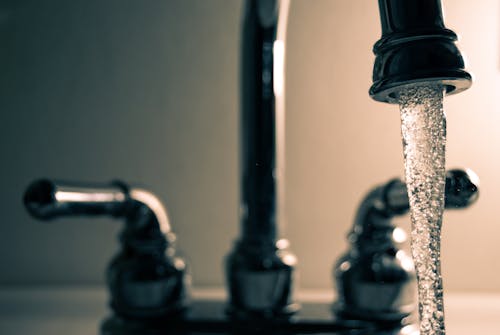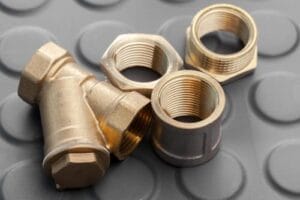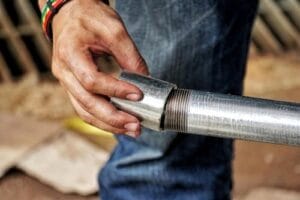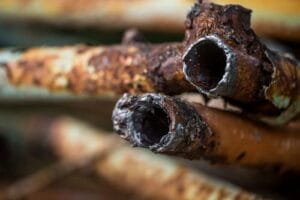What Is Galvanized Plumbing? Definition, Risks, and Replacement Options

Key Takeaways:
- Galvanized Pipes Deteriorate Over Time: Galvanized plumbing, which was once a popular material, corrodes and weakens over time, leading to leaks, rust, and reduced water flow.
- Health Risks and Contamination: Rust and corrosion in galvanized pipes can lead to water contamination, potentially causing health issues due to the presence of lead and other harmful substances.
- Replacement Is Essential: It’s important to replace galvanized pipes with modern materials like copper or PEX to ensure the longevity, safety, and efficiency of your plumbing system.
Galvanized steel plumbing has been a staple in American homes for over a century. It’s a type of plumbing system that uses steel pipes coated with a protective layer of zinc to prevent rusting and corrosion. This process, known as galvanization, was a game-changer in the construction industry, offering a durable and long-lasting solution for residential plumbing.
However, despite its popularity and widespread use, galvanized plumbing has its share of problems. As the zinc coating wears off over time, the underlying steel becomes exposed to water and oxygen, leading to rust and corrosion. This can cause reduced water pressure, restricted flow, and even leaks or ruptures in the pipes.
This article will dive deeper into the history and characteristics of galvanized plumbing, exploring its advantages and disadvantages. We’ll also discuss how to identify galvanized pipes in your home and what options you have for dealing with aging or failing galvanized plumbing systems.
 What Are Galvanized Pipes?
What Are Galvanized Pipes?
Galvanized pipes are steel pipes that have been coated with a layer of zinc to prevent corrosion. This process, called galvanization, has been used for over a century to create durable plumbing solutions.
The Galvanization Process
The galvanization process involves cleaning the steel pipe to remove any rust, oil, or debris, followed by immersion in a bath of molten zinc. This results in a metallurgical bond between the zinc and the steel, creating a protective coating on the pipe’s surface.
The zinc coating acts as a sacrificial anode, meaning it’ll corrode before the steel, offering corrosion protection to the pipe. This coating not only provides durability but also adds an aesthetically pleasing silver-gray finish to the pipe, making it suitable for both functional and decorative purposes.
Composition and Types of Galvanized Pipes
Galvanized pipes are composed of steel pipes with a protective zinc coating. The alloy of the steel pipe ensures its strength and structural integrity, while the zinc coating acts as a barrier against corrosion. The zinc coating, applied through the galvanization process, provides a long-lasting shield that prevents rust and corrosion even in challenging environments.
This combination of steel and zinc coating makes galvanized pipes ideal for a wide range of plumbing and industrial applications where durability and corrosion resistance are critical. There are two main types of galvanized pipes:
- Hot-dip galvanized pipes: These pipes are dipped in a bath of molten zinc, resulting in a thicker and more durable coating.
- Electro-galvanized pipes: These pipes are coated with zinc using an electrolytic process, resulting in a thinner but more uniform coating.
Both types of galvanized pipes offer excellent corrosion resistance and are suitable for various applications, depending on the specific requirements and environmental conditions.
 Advantages and Disadvantages of Galvanized Plumbing
Advantages and Disadvantages of Galvanized Plumbing
Galvanized pipes have been a popular choice for plumbing systems due to their affordability and corrosion resistance. However, they also come with certain drawbacks that homeowners should be aware of.
Durability and Lifespan
One of the main advantages of galvanized pipes is their durability. The zinc coating protects the steel from rust and corrosion, allowing these pipes to last for several decades. In ideal conditions, galvanized plumbing can have a lifespan of 40-50 years.
However, the durability of galvanized pipes depends on various factors, such as:
- Water quality: Hard water with high mineral content can accelerate the deterioration of the zinc coating.
- Installation: Improper installation or damage during the installation process can compromise the pipes’ longevity.
- Environment: Exposure to certain chemicals or extreme temperatures can affect the pipes’ durability.
Over time, even with proper maintenance, the zinc coating will eventually wear away, exposing the steel to corrosion and leading to the need for replacement.
Common Problems and Issues
Despite their durability, galvanized pipes can encounter several problems over time. Some of the most common issues include:
- Corrosion and rust buildup: As the zinc coating deteriorates, the pipes become susceptible to internal corrosion and rust buildup. This can lead to reduced water flow, discolored water, and even leaks.
- Lead contamination: In older homes, galvanized pipes may be connected to lead plumbing components, which can leach lead into the water supply, posing health risks.
- Mineral buildup: Hard water can cause mineral deposits to accumulate inside the pipes, further restricting water flow and increasing the risk of clogs and leaks.
- Reduced water pressure: As corrosion and mineral buildup progress, the inner diameter of the pipes decreases, resulting in lower water pressure throughout the plumbing system.
- Difficult repairs: Galvanized pipes can be challenging to repair due to their rigid nature and the potential for corrosion to spread beyond the initial problem area.
Recognizing these common issues is essential for homeowners with galvanized plumbing, as they may need to consider repairs, partial replacements, or complete re-piping to ensure the efficiency and safety of their water supply. We also recommend you get electrical and home heating set up by us so everything is single hands.
Identifying Galvanized Pipes in Your Home
I’ll show you how to determine if your home has galvanized pipes. It’s important to identify these pipes, as they may need repairs or replacement due to age and potential issues.
Visual Inspection
An easy way to spot galvanized pipes is to look where the piping enters your home and scratch the surface. If the pipe has a silver-gray color with visible threads, it’s likely galvanized steel. Copper pipes, in contrast, will look like a shiny penny when scratched. Plastic pipes, such as PVC or PEX, are usually white, blue, or red and won’t have the threaded appearance of galvanized pipes.
As galvanized pipes age, their appearance can change. The zinc coating may become duller or darker, and you might notice signs of corrosion or rust. If your home was built before the 1970s and has original plumbing, there’s a good chance you have galvanized pipes.
Testing Methods
In addition to visual inspection, you can use a few simple tests to confirm if your pipes are galvanized:
- Magnet test: Galvanized steel is magnetic, so if a magnet sticks to your pipes, they’re likely galvanized. Copper and plastic pipes won’t attract a magnet.
- Scratch test: Gently scratch the surface of the pipe with a screwdriver or knife. If the scratched area reveals a silver-gray color, it’s probably galvanized steel. Copper will show a reddish-gold color when scratched.
- Professional inspection: If you’re unsure or want a definitive answer, consider hiring a licensed plumber to inspect your plumbing system. They can identify the type of pipes and assess their condition.
Knowing the age of your home and its plumbing is also helpful. Galvanized pipes typically last 40-50 years, so if your house was built before the 1970s and has original plumbing, it’s likely time to consider repairs or replacement. Also read our guide on air gaps in plumbing.
Risks and Dangers Associated with Galvanized Plumbing
As galvanized pipes age, they can pose several risks and dangers to your home’s water supply and overall plumbing system. Let’s take a closer look at some of the most significant issues associated with galvanized plumbing.
 Corrosion and Rust
Corrosion and Rust
One of the primary concerns with galvanized pipes is corrosion and rust buildup. Over time, the protective zinc coating on these pipes erodes, exposing the steel underneath to water and oxygen. This exposure leads to the formation of rust, which can accumulate inside the pipes, causing blockages and reducing water flow.
Rust particles can also break off and enter your water supply, resulting in discolored, foul-tasting, or foul-smelling water. In severe cases, the corrosion can cause leaks or even pipe failure, leading to costly water damage and repairs.
Lead Contamination
Another significant risk associated with galvanized plumbing is lead contamination. While galvanized pipes themselves don’t contain lead, they may be connected to lead pipes or soldered with lead in older homes. As the galvanized pipes corrode, they can release lead from these connections into the water supply.
Exposure to lead can have severe health consequences, particularly for children and pregnant women. Lead poisoning can cause developmental delays, learning difficulties, and other neurological problems. It’s crucial to test your water for lead if you have galvanized plumbing and take appropriate measures to mitigate any risks. Are you also wondering how to solder plumbing?
Other Plumbing Issues
In addition to corrosion and lead contamination, galvanized pipes can cause other plumbing issues:
- Reduced water pressure: As rust and mineral buildup accumulate inside the pipes, they can restrict water flow, resulting in low water pressure throughout your home.
- Frequent clogs: The rough interior surface of corroded galvanized pipes can trap sediment and debris, leading to frequent clogs and backups.
- Difficulty with repairs: Galvanized pipes can be challenging to repair due to their age and the extent of corrosion. In many cases, the best solution is to replace the affected pipes entirely.
- Incompatibility with modern plumbing: Galvanized pipes may not be compatible with newer plumbing materials, such as copper or PVC, which can lead to corrosion or leaks at the connection points.
Given these potential risks and dangers, it’s essential for homeowners with galvanized plumbing to monitor their systems closely and consider upgrading to more modern, safer alternatives. Regular inspections by a licensed plumber can help identify any issues early on and prevent more severe problems down the line.
When to Consider Replacing Galvanized Pipes
As galvanized pipes age, they’re prone to various issues that can affect the safety and efficiency of a home’s water supply. It’s crucial for homeowners to recognize the signs that indicate it’s time for a replacement.
Signs It’s Time for a Replacement
- Discolored water: If the water coming from your taps has a yellowish, brownish, or reddish tint, it could be a sign of rust and corrosion in your galvanized pipes. This discoloration is not only unsightly but also a potential health hazard.
- Low water pressure: Over time, mineral buildup and corrosion can narrow the inside diameter of galvanized pipes, resulting in reduced water flow and pressure. If you’ve noticed a significant decrease in water pressure throughout your home, it may be due to aging galvanized plumbing.
- Frequent leaks: As galvanized pipes corrode, they become more susceptible to leaks. If you’re experiencing frequent leaks or notice visible signs of corrosion on exposed pipes, it’s a clear indication that your plumbing system needs attention.
- Visible corrosion: Check exposed pipes, such as those in your basement or crawl space, for signs of corrosion. If you see flaking, dimpling, or rust on the exterior of the pipes, it’s likely that the interior is also deteriorating.
If you suspect that your galvanized pipes need replacement, consult with a licensed plumber to assess your plumbing system’s condition and discuss your options. They can provide expert guidance on the best course of action for your specific situation, ensuring that your home’s water supply remains safe, efficient, and reliable for years to come.
Replacement Options for Galvanized Plumbing
When it’s time to replace galvanized pipes, homeowners have several modern piping materials to choose from. Each option offers unique benefits and drawbacks, so it’s essential to weigh the pros and cons before making a decision.
Modern Piping Materials
PEX (cross-linked polyethylene) is a flexible, durable plastic piping that’s become increasingly popular for residential plumbing. It’s resistant to corrosion, easy to install, and can withstand extreme temperatures. PEX also minimizes noise from water flow and is less likely to burst in freezing conditions.
Copper piping is another common choice, known for its durability, reliability, and resistance to corrosion. It’s compatible with most modern plumbing fixtures and has a long lifespan of 50-70 years. However, copper is more expensive than PEX and requires professional installation.
CPVC (chlorinated polyvinyl chloride) is a rigid plastic piping that’s resistant to corrosion and chemical breakdown. It’s less expensive than copper but more costly than PEX. CPVC is suitable for both hot and cold water applications and is easy to install.
PVC (polyvinyl chloride) is a popular choice for drain, waste, and vent lines but is not suitable for hot water applications. It’s affordable, lightweight, and easy to work with, making it a cost-effective option for certain plumbing needs.
Costs Involved in Repiping
The cost of replacing galvanized pipes varies depending on factors such as the size of the home, the extent of the repiping, the chosen material, and local labor costs. On average, a whole-house repipe can cost between $4,000 and $15,000.
PEX is generally the most affordable option, with costs ranging from $0.50 to $2 per linear foot for materials. Copper piping is more expensive, with materials costing $2 to $4 per linear foot. CPVC falls in between, with material costs ranging from $0.50 to $1 per linear foot.
In addition to material costs, homeowners must factor in labor costs, which can range from $50 to $200 per hour, depending on the plumber’s experience and location. Other expenses may include drywall repair, painting, and permits.
While the upfront cost of repiping can be substantial, it’s a worthwhile investment in the long run. Modern piping materials offer improved safety, efficiency, and peace of mind, ensuring a reliable water supply for years to come.
Maintenance and Preventive Measures
Maintaining galvanized pipes is crucial for ensuring their longevity and preventing costly repairs. Here are some tips and preventive measures to keep your galvanized plumbing system in good condition.
Tips for Maintaining Galvanized Pipes
- Inspect regularly: I make it a point to inspect my galvanized pipes regularly, looking for signs of corrosion, rust, leaks, or changes in water pressure. Catching issues early can save me from more extensive repairs down the line.
- Monitor water quality: I keep an eye on my water quality, as changes in color, taste, or odor can indicate problems with my galvanized pipes. If I notice any changes, I contact a professional plumber for an assessment.
- Avoid harsh chemicals: I refrain from using harsh chemicals, such as drain cleaners, in my galvanized pipes. These products can accelerate corrosion and damage the zinc coating. Instead, I opt for gentler, enzyme-based drain cleaners or mechanical methods like plunging or snaking.
- Insulate pipes: To protect my galvanized pipes from extreme temperatures, I ensure they’re properly insulated. This helps prevent freezing and bursting during cold weather and reduces the risk of condensation and corrosion in humid environments.
- Address leaks promptly: If I detect any leaks in my galvanized pipes, I address them promptly. Even small leaks can lead to significant water damage and encourage corrosion if left unchecked. I call a licensed plumber to repair leaks and inspect for any additional damage.
By following these maintenance tips and preventive measures, I can extend the life of my galvanized pipes and avoid costly repairs. However, it’s essential to recognize when it’s time to replace aging galvanized plumbing to ensure the safety and reliability of my home’s water supply.
Conclusion
Galvanized plumbing has been a reliable and affordable solution for many homes, but it’s crucial to understand its limitations and potential issues. As these pipes age, they can lead to various problems that compromise water quality and pressure. It’s essential for homeowners to regularly inspect their plumbing, identify signs of deterioration, and take proactive measures to maintain the system’s integrity.
If I suspect that my home has galvanized pipes nearing the end of their lifespan, I’ll consult a licensed plumber to assess the situation and discuss replacement options. By staying informed and taking timely action, I can ensure a safe, efficient, and reliable water supply for my household.
FAQs
What do I need to know about galvanized pipes?
Galvanized pipes are steel pipes that have been coated with a layer of zinc to prevent rust and corrosion. However, over time, this coating can wear off, leading to rust buildup inside the pipes, which can affect water quality and flow.
How long do galvanized steel pipes last?
Galvanized steel pipes typically last around 40 to 50 years. However, this lifespan can vary depending on factors such as water quality, pipe installation, and maintenance.
What are the dangers of galvanized water pipes?
The dangers of galvanized water pipes include rust and corrosion, which can lead to leaks, reduced water pressure, and contamination of drinking water due to rust particles or lead if the pipes were manufactured before regulations changed.
How can I tell if my home’s pipes are made of galvanized steel?
You can identify galvanized pipes by their silver or gray color and threaded ends. If you scratch the surface and see a shiny metal underneath, it’s likely galvanized steel.
Why should I replace my galvanized pipes?
You should replace your galvanized pipes to prevent potential health risks from rust and contaminants, improve water flow and pressure, and avoid costly water damage from leaks that can occur due to the deterioration of older pipes.
What is the cost to replace galvanized pipes?
The cost to replace galvanized pipes can vary widely depending on the size of the plumbing system and the materials used. On average, homeowners can expect to pay between $1,500 to $15,000 for a complete replacement, including labor and materials.
What types of pipes can I replace galvanized pipes with?
You can replace galvanized pipes with modern alternatives such as PEX pipes, PVC pipes, or copper pipes. Each option has its own benefits, such as flexibility, resistance to corrosion, and ease of installation.
Do older homes typically have galvanized steel plumbing?
Yes, homes built before 1960 often have galvanized steel plumbing. If you’re buying a house of that age, it’s advisable to have the plumbing system inspected for galvanized water pipes.
What issues can rusted galvanized water pipes cause?
Rusted galvanized water pipes can cause several issues, including reduced water pressure, discolored tap water, leaks that can lead to water damage, and increased risk of plumbing emergencies.
How does replacing galvanized pipes improve my plumbing system?
Replacing galvanized pipes improves your plumbing system by ensuring better water quality, increasing water pressure, reducing the risk of leaks, and enhancing the overall efficiency and reliability of your plumbing.
